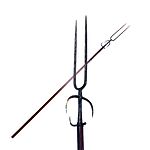War fork
| War fork | |
|---|---|

|
|
| Information | |
| Weapon type: | Polearm |
| Use: | War weapon, tool |
| Creation time: | approx. 13th century |
| Working time: | approx. 14th century - 16th century |
| Region of origin / author: |
England , peasant army |
| Distribution: | Europe |
| Overall length: | approx. 200 cm, variable |
| Blade length: | approx. 90 cm, variable |
| Handle: | Wood, leather, metal |
| Particularities: | Different fork shapes |
| Lists on the subject | |
The war fork is a medieval polearm .
It comes from the agricultural sector and was developed from the dung fork . The first war forks were normal pitchforks. When the fighting value of the forks was recognized (around 1400), they began to specialize in these weapons. The fork tips have been bent straight and reinforced. Some war forks were provided with small ax blades or parrying hooks. Since the war forks were easy and inexpensive to manufacture, they were widely used in Italy until the end of the 16th century .
use
Forks of war were used against horsemen and foot troops. You could knock riders off their horses or even disarm them. From the 16th century onwards , forks of war were hardly used any more, as the armaments were meanwhile so developed that they could not be penetrated.
See also
literature
- Wendelin Boeheim: Handbook of the armory . Fourier Verlag, Wiesbaden 198 (original 1890), ISBN 3-921695-95-3 .
- Liliane and Fred Funcken: weapons and armor . Orbis Verlag, Munich 1990, ISBN 3-572-07893-8